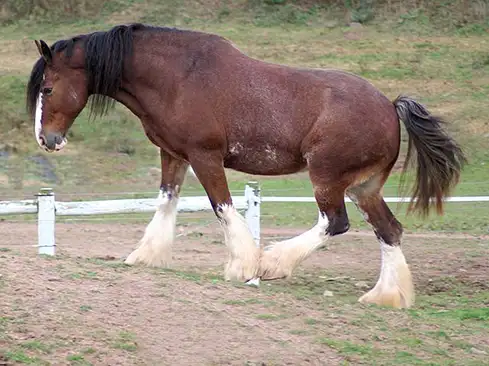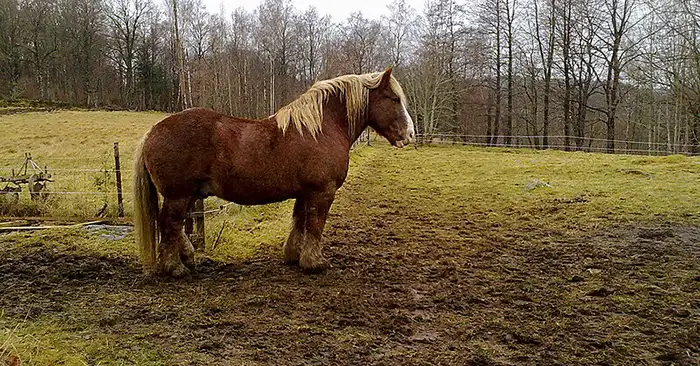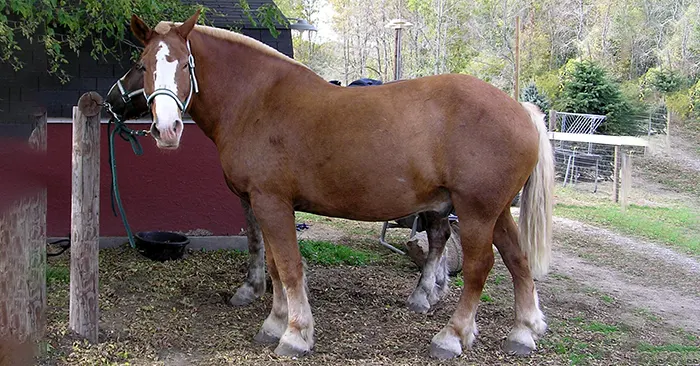Originating from Scotland, Clydesdales are renowned for their imposing stature, remarkable strength, and gentle temperament. In this blog, we’ll delve into their physical characteristics, temperament, health considerations, care requirements, and much more.
Physical Characteristics

Clydesdales are instantly recognizable by their impressive size and distinctive markings. Standing tall at around 16 to 18 hands high and weighing between 1,800 to 2,300 pounds, these majestic horses boast a muscular build, a broad chest, and powerful legs. Their most recognizable feature is their feathering – the long hair that adorns their lower legs, adding to their regal appearance.
Temperament and Behavior
Despite their imposing size, Clydesdales are known for their gentle and docile nature. They exhibit a calm demeanor and are often described as friendly and sociable animals. These horses possess a willingness to work and are highly trainable, making them ideal for a variety of tasks, from farm work to pleasure riding.
Health and Lifespan
Overall, Clydesdales are a hardy and resilient breed with relatively few health issues. However, like all horses, they require regular veterinary care, including vaccinations, dental check-ups, and deworming. Proper nutrition and a suitable exercise regimen are crucial for maintaining their health and well-being. With proper care, Clydesdales can live well into their late teens or twenties.
Care and Maintenance
Caring for Clydesdales is a holistic endeavor encompassing shelter, spacious pastures, and balanced nutrition. Their size demands ample grazing areas for exercise. Consistent grooming is vital to maintain their luxurious coat and feathering, preventing tangles. Regular hoof care and exercise routines are crucial to ward off common ailments like hoof abscesses and obesity, ensuring their optimal health and well-being.
Origin
The origins of the Clydesdale horse breed trace back to the banks of the River Clyde in Lanarkshire, Scotland, where they emerged as indispensable workhorses for local farmers in the 18th century. Influenced by strong Flemish and Flemish stallions imported to Scotland by the Duke of Hamilton, these majestic animals inherited their imposing stature and robust build. Initially known as “Clydesdale” horses due to their association with the River Clyde, they rapidly gained renown for their strength, agility, and willingness to toil in the challenging terrain of Scotland’s agricultural landscape.
As the Industrial Revolution swept across Britain, Clydesdales found themselves in even greater demand, becoming favored draft horses for pulling heavy loads and plowing fields. Their reputation for reliability and stamina spread beyond Scotland’s borders, attracting attention internationally. In the late 19th and early 20th centuries, Clydesdales made their way to North America, where they continued to thrive, becoming prized assets on farms and logging operations. Today, while their numbers have diminished compared to their heyday, Clydesdales remain cherished symbols of strength and heritage, revered for their contributions to agriculture and their enduring legacy as iconic equine figures.
Breed’s Purpose and Use
Originally bred as draft horses for demanding farm tasks, Clydesdales have diversified their roles, excelling in logging, carriage pulling, and dazzling audiences as show animals. Their robust build, endurance, and friendly nature render them adaptable partners across a spectrum of endeavors, be it labor-intensive agricultural work, elegant parades, or captivating exhibitions. Clydesdales epitomize versatility and remain prized assets in numerous arenas, thanks to their enduring strength and gentle temperament.
Conclusion
In conclusion, the Clydesdale horse breed embodies strength, grace, and versatility. With their striking appearance, gentle temperament, and impressive capabilities, they have earned a special place in the hearts of horse enthusiasts worldwide. Whether working on the farm, participating in competitions, or simply enjoying leisurely rides, Clydesdales continue to captivate and inspire admiration.
References
- https://www.clydesusa.com/clydesdales/breed-information/
- https://equusmagazine.com/horse-world/clydesdale-horses-53625
- https://www.clydesdalehorsesociety.com/about-the-breed


